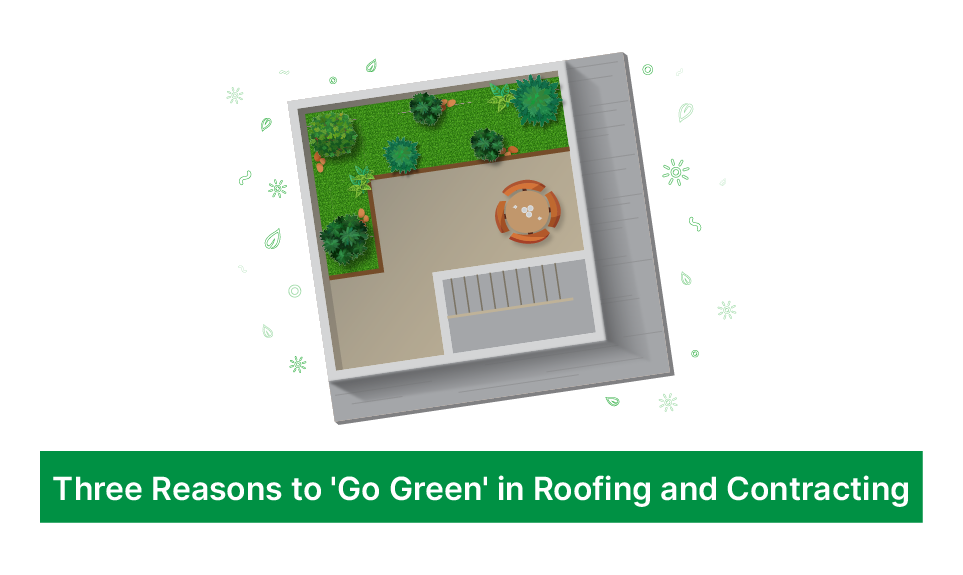According to a recent report from 2010–2019, harmful carbon emissions have never been higher in human history. António Guterres has warned, with scientists arguing that it is “now or never” to limit global warming to 1.5 degrees. It has become a major challenge to manage climate change in recent years. People have started to adopt best practices to be environmentally responsible for combating climate change and global warming. One of the best practices that significantly changed is using eco-friendly materials, switching to renewable materials, and recycling.
Owners of roofing businesses have started to make a difference by adopting green technology to combat climate change. It is no wonder homeowners have already started to install green roofs. According to a report, The market for green roofs keeps expanding at a CAGR of 17% and is expected to reach USD 4.2 billion by 2027. The focus on being “environmentally friendly” has provided many business owners with renewed hope for increased profitability as new business opportunities have emerged.
If you are still on the fence about switching to green roofs, we have put together a list of reasons to “go green” now.
Positive impact on the environment
“Green roof,” the name says it all. A green roof is nothing but a conventional roof, and it comes up with a vegetation layer with a waterproof membrane. The vegetation may include herbs, grass, and even vegetables. Green roofs on top of your building give an aesthetic property and impact the environment in several ways.
Improves stormwater management
Urban areas generate more stormwater runoff than other areas due to impervious surfaces. The water infiltration leads to two significant issues, flooding and stream erosion. Runoff from impervious surfaces increases peak flow and decreases natural groundwater flow. Improper stormwater management leads to water pollution, which negatively impacts the environment.
The green roof reduces flooding risks by improving drainage and irrigation systems. The vegetation layer helps store rainwater and reduces the runoff caused by storms. As a result, green roofs reduce water inflow into sewage systems. According to an article, green roofs can reduce peak runoff by up to 65% and delay peak discharge. It improves the runoff water quality by reducing the acidity of rainfall.
Reduces the urban heat island effect
The urban heat island (UHI) effect occurs when a region experiences higher warmth than other regions. Residential, commercial, and industrial buildings are constructed with conventional building materials. They are good at retaining heat by absorbing the sun’s radiation. It means that they re-emit the sun’s heat and increase the region’s temperature.
UHI can negatively impact the water and air quality compared to neighboring areas. Considering these negative impacts, scientists suggest green roofs can be installed to mitigate the effect of UHI.
Green roofs have been proven effective in minimizing heat absorption and reducing the roof surface temperature and surrounding area. It minimizes the surrounding area’s ambient temperature by 5° F. A research article estimates that green roofs can reduce 50% of New York City’s average surface temperature to 1.4° F.
Better healthy living
One of the essential benefits of green roofs is the improvement of living health conditions. A research article states that green roofs could improve the air quality of homes. The vegetation layer in green roofs acts as a natural filter, trapping air pollutants and synthesizing harmful gases caused by air pollution. Researchers estimate a green roof can remove 0.2kg of dust particles yearly for every square meter of green roof.
Conventional building materials absorb heat directly from outdoors and pass it on to the indoors, increasing the temperature of the indoor environment. The green roof helps reduce the high temperature by acting as a buffer between outdoors and indoors. The research concludes that in summer, the green roof reduces indoor temperature by 2°C.
Also, a green roof has an insulation layer and reduces the heat radiation through a building envelope. It has the capability of reducing heat transportation and emission. Additionally, it provides an energy consumption advantage for heating and cooling.
Studies have shown that those who live in homes with green roofs suffer from fewer respiratory problems and allergies. Thanks to green roofs, homeowners can enjoy breathing easier, and their homes will be more comfortable in the summertime. We can conclude that green roofs have the potential to enhance the living conditions of residents and provide a comfortable, healthy environment.
Saves you money
Green roofs offer a chance to save a lot of money in the long term, even though green roofs cost more—the economic benefits of building green start with cutting down energy costs. The green roof insulates and helps to regulate the building temperature. This helps decrease the energy used to cool or heat a building.
Since the insulation material reflects away the heat during summer and retains heat during winter, homeowners have a dramatic change in energy bills. The green roof can also increase the efficiency of solar panels and reduce total energy costs.
Not to mention, installing a green roof can eliminate spending more money on health bills, medications, or hospital visits. In the long run, a green roof is a sound investment for any business and is suitable for the environment.
Conclusion
Roofing service providers who go green provide valuable roofing solutions to their customers and the environment. You can switch for various reasons, from environmental to health to economic. With the ever-growing popularity of green buildings, more and more homeowners are looking for sustainable and affordable roofing solutions. If you’re looking for a way to make your business more environmentally friendly and increase your bottom line, consider switching to green roofing.
If you are a roofing business enthusiast, take a look at our blogs on the roofing industry.






